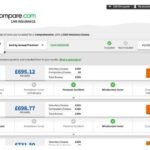Car insurance deductibles are a crucial element of any vehicle owner’s financial planning. They represent the amount you pay out-of-pocket before your insurance company steps in to cover damages. Understanding these amounts and their relationship to premiums is essential for making informed decisions about your coverage. This guide provides a comprehensive overview of deductibles, their impact on premiums, and how to navigate the claim process effectively.
This discussion delves into the specifics of different deductible types, such as collision and comprehensive, and examines the correlation between deductible amounts and insurance premium costs. We’ll also explore the financial implications of claims, highlighting the importance of balancing cost and coverage. By the end, you’ll be equipped to make informed choices about your car insurance deductibles, ensuring your financial well-being in case of an accident or other covered event.
Understanding Car Insurance Deductibles and Their Impact
Car insurance deductibles are a crucial component of your policy, impacting both your premium costs and your out-of-pocket expenses in the event of a claim. Understanding how deductibles work is essential for making informed decisions about your coverage and managing your finances.
Defining Deductibles
A car insurance deductible is the amount of money you pay out-of-pocket for covered damages before your insurance company begins to pay. Different types of deductibles cover various scenarios.
-
Collision: This type of deductible covers damage to your vehicle resulting from an accident. Examples include impacts with other vehicles, objects, or the environment.
-
Comprehensive: This deductible covers damage to your vehicle from events other than collisions. Examples include vandalism, theft, fire, hail damage, or falling objects.
-
Other Deductibles: Some policies might include deductibles for specific types of damage like glass breakage, or specific types of accidents.
The amount of a deductible is influenced by several factors, including the type of vehicle, the driver’s history, the geographic location, and the insurance company’s underwriting standards. Policyholders may have the option to choose from various deductible amounts.
Examples of deductible amounts for different policies include:
-
Policy A: $250 for collision and comprehensive.
-
Policy B: $500 for collision and comprehensive.
-
Policy C: $1000 for collision and comprehensive.
| Deductible Type | Description | Typical Range |
|---|---|---|
| Collision | Covers damage to your car caused by an accident. | $250 – $1000 |
| Comprehensive | Covers damage to your car from events other than collisions (e.g., vandalism, theft). | $250 – $1000 |
| Glass Breakage | Covers damage to your car’s windows or windshields. | $50 – $250 |
Impact on Insurance Premiums
Choosing a higher deductible typically results in lower insurance premiums. Insurance companies view higher deductibles as a signal that policyholders are willing to absorb greater out-of-pocket costs in the event of a claim. This reduced risk translates to lower premiums for the company, which they then pass on to the policyholder.
The reasons behind this correlation include:
-
Reduced Risk: Insurance companies calculate risk based on the likelihood of a claim. A higher deductible implies a lower likelihood of a claim, as the policyholder is more responsible for initial costs.
-
Lower Administrative Costs: Processing fewer claims results in lower administrative costs for the insurer, further contributing to lower premiums.
Potential savings associated with higher deductibles can be substantial, as demonstrated in the table below:
| Deductible Amount | Estimated Premium Cost |
|---|---|
| $250 | $1500 |
| $500 | $1200 |
| $1000 | $900 |
Understanding Your Coverage

Source: bjak.my
Locating your policy’s deductible information is straightforward. It’s usually detailed within your policy documents.
-
Policy Documents: Look for sections specifically titled “Deductibles,” “Coverage Summaries,” or “Policy Details.”
-
Online Portals: Many insurance companies provide online access to policy information. Check your account portal for detailed information on your policy.
-
Paper Policies: If your policy is in paper format, carefully review the relevant sections for specific deductible amounts.
Understanding your policy’s specific deductible is critical to manage your finances and expectations effectively.
Making Informed Decisions

Source: bankrate.com
Choosing a deductible involves balancing the cost of insurance premiums with potential out-of-pocket expenses. High deductibles offer lower premiums but higher potential out-of-pocket costs in the event of a claim. Low deductibles provide lower out-of-pocket costs but increase premiums.
| Feature | High Deductible | Low Deductible |
|---|---|---|
| Premium Cost | Lower | Higher |
| Out-of-Pocket Cost | Higher | Lower |
| Claim Processing Time | Potentially faster | Potentially slower |
Handling Claims
Filing a claim involves specific procedures, depending on your insurance provider.
-
Contact Your Insurer: Contact your insurance company to initiate the claim process. They will guide you through the necessary steps.
-
Gather Information: Collect all relevant information, including the date, time, location of the accident, and details of the involved parties.
-
Document Everything: Take photos of the damage and keep records of all communications.
Impact on Your Finances
Claims with deductibles can significantly affect your budget. Understanding the financial implications is crucial for effective financial planning.
-
Unforeseen Expenses: A claim can lead to unexpected expenses, especially if the deductible is high.
-
Budget Adjustments: It’s wise to factor in potential claim costs when creating a budget.
-
Long-Term Implications: Understanding how deductibles affect your finances is crucial for long-term financial planning.














